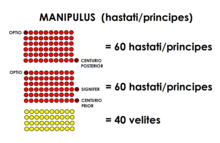Principes
 |
| Part of a series on the |
| Military of ancient Rome |
|---|
|
|
Principes (sg.: princeps) were spearmen, and later swordsmen, in the armies of the early Roman Republic. They were men in the prime of their lives who were fairly wealthy, and could afford decent equipment. They were the heavier infantry of the legion who carried large shields and wore good quality armor.[1]
Their usual position was the second battle line. They fought in a quincunx formation, supported by light troops. They were eventually disbanded after the so-called "Marian reforms" of 107 BC.
History and deployment
According to
3rd and 4th century
In the early 3rd and late 4th centuries BC, men were sorted into classes based on wealth, the principes being the wealthiest after the
According to Livy, in this type of legion, the 900 principes formed 15 maniples, military units of 60 men each.[1] The principes stood in the second battle line, behind hastati of the first line and in front of the triarii in the third.[5] In a pitched battle, the leves, javelin armed light infantry would form up at the front of the legion and harass the enemy with javelin fire to cover the advance of the hastati, light spearmen.[7]
If the hastati failed to break the enemy during their engagement, they would fall back and let the heavier principes take over. If the principes could not break through, they would retire behind the heavy triarii spearmen who would then engage the enemy in turn. The equites, cavalrymen, were used as flankers and to pursue routing enemies. The rorarii and accensi in the final battle line were some of the least dependable troops, and were used in a support role, providing mass and reinforcing wavering areas of the line.[7]
Polybian system

By the time of the
The principes had been increased in number to 1,200 per legion, and formed 10 maniples of 120 men each.[10] The rorarii and accensi had been disbanded. Leves had been replaced with velites, who had a similar role, with forty of them being attached to each maniple in the legion.[10] Pitched battles were conducted in a similar fashion; the velites would gather at the front and fling javelins to cover the advance of the hastati, who had also been re-armed with swords. If the hastati failed to break the enemy, they would fall back on the principes. If the principes could not break them, they would retire behind the triarii, who would then engage the enemy.[11]
This order of battle was almost always followed, the Battle of the Great Plains and the Battle of Zama being among the few notable exceptions. At the Great Plains, Scipio, the Roman general, formed his men up in the usual manner, but once the hastati had begun to engage the enemy, he used his principes and triarii as a flanking force, routing the opposing Carthaginians.[12][13] At Zama, Scipio arranged his men into columns, side by side, with large lanes in between. The opposing Carthaginian elephants were drawn into these lanes where many were killed by velites without inflicting many casualties on the Romans. Once the surviving elephants had been routed, he formed his men into a long line with his triarii and principes in the centre and hastati on the flanks, ready to engage the Carthaginian infantry.[13]
Late republic
With the
See also
References
- ^ a b Southern 2007, p. 90
- ^ Southern 2007, p. 89
- ^ Penrose 2005, p. 29
- ^ Southern 2007, p. 88
- ^ a b c Smith 1859, p. 495
- ^ Forsythe, Gary (2005). A Critical History of Early Rome. University of California Press. p. 305.
- ^ ISBN 0-415-14953-3.
- ^ Southern 2007, p. 92
- ISBN 0-415-14953-3.
- ^ a b Smith 1859, p. 496
- ^ Penrose 2005, p. 33
- ^ Niebuhr, Barthold; Schmitz, Leonhard (1849). Lectures on the History of Rome, From the Earliest Times to the Fall of the Western Empire. Taylor, Walton, and Maberly. p. 151.
- ^ ISBN 1-85532-598-5.
- ^ Southern 2007, p. 94
- ^ Smith 1859, p. 506
Bibliography
- Penrose, Jane (2005). Rome and Her Enemies: An Empire Created and Destroyed by War. Osprey Publishing. p. 29. ISBN 1-84176-932-0.
- ISBN 0-19-532878-7.
- Smith, William (1859). A Dictionary of Greek and Roman Antiquities. Little, Brown, and Co. p. 496. ISBN 0-89341-166-3.
